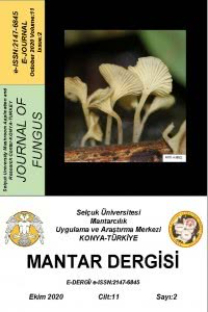Tarım Topraklarındaki Isıya Dirençli Fungusların Belirlenmesi Üzerine Ön Çalışma
Tarım Toprağı, Isıya Dirençli Fungus, Geleneksel Yöntem
Preliminary Study on the Determination of Heat Resistant Fungi in Agricultural Soils
Agricultural Soils, Heat Resistant Fungi, Conventional Method,
___
- Ali, A.M., Moghazy, S., Shaban, G., El- Sababty Z. (2009). Heat-Resistant Fungi Isolated from Soil in Minia Governorate, Egypt, Assiut Univ. J. of Botany 38(2) 93-106Barnett HL, Hunter BB, Illustrated Genera of Imperfect Fungi (1999), 4. Edition. 218 pp. APS Press, The American Phytopathological Society. St. Paul, Minnesota, USA,
- Benkerroum, N. (2016). Mycotoxins in dairy products: a review. International dairy journal, 62, 63-75.
- Bouhoudan, A., Chidi, F., Tantaoui-Elarak, A., & Khaddor, M. (2018). The effect of carbon source concentration on toxigenesis and lipase activity of Penicillium aurantiogriseum. Agriculture & Forestry/Poljoprivreda i Sumarstvo, 64(3).
- Braga, R. M., Padilla, G., & Araújo, W. L. (2018). The biotechnological potential of Epicoccum spp.: diversity of secondary metabolites. Critical reviews in microbiology, 44(6), 759-778.
- Chadha, B. S., Kaur, B., Basotra, N., Tsang, A., & Pandey, A. (2019). Thermostable xylanases from thermophilic fungi and bacteria: Current perspective. Bioresource technology.
- Chandrashekar, M. A., Soumya, P., and Raju, N. S. (2014). Fungal diversity of rhizosphere soils in different agricultural fields of Nanjangud Taluk of Mysore District, Karnataka, India. Int. J. Curr. Microbiol. App. Sci, 3(5) 559-566.
- Chen, A. J., Sun, B. D., Houbraken, J., Frisvad, J. C., Yilmaz, N., Zhou, Y. G., & Samson, R. A. (2016). New Talaromyces species from indoor environments in China. Studies in mycology, 84, 119-144.
- Demirci, A.Ş. and Arici, M. (2006). Margarinde Yüksek Sıcaklığa Dayanıklı Küflerin Belirlenmesi ve Tanımlanması. Türkiye 9. Gıda Kongresi; 24-26. Tekirdağ.
- Gil-Serna, J., Vázquez, C., González-Jaén, M., & Patiño, B. (2018). Wine contamination with ochratoxins: A Review. Beverages, 4(1), 6.
- Houbraken, J. Samson, R.A. (2006). Standardization of methods for detecting heat resistant fungi. Advances in Experimental Medicine and Biology, 571, 107-111.
- Hurrass, J., Heinzow, B., Aurbach, U., Bergmann, K. C., Bufe, A., Buzina, W., Heinz, W. (2017). Medical diagnostics for indoor mold exposure. International journal of hygiene and environmental health, 220(2), 305-328.
- Ibrahim, S., Anusha, M.B., Udhayaraja, P. (2014). Isolation of heat resistant fungi from canned fruits. Golden Research Thoughts, 3(11) 1-10.
- Klich, M. A. (2002). Identification of common Aspergillus Species, First edition, Utrecht, The Netherlands: Centraalbureau voor Schimmelcultures.
- Lim, L., Senba, H., Kimura, Y., Yokota, S., Doi, M., Yoshida, K. I., & Takenaka, S. (2019). Influences of N-linked glycosylation on the biochemical properties of aspartic protease from Aspergillus glaucus MA0196. Process biochemistry, 79, 74-80.
- Moazam, S., & Denning, D. W. (2017). Aspergillus nodules in chronic granulomatous disease attributable to Aspergillus ochraceus. Medical mycology case reports, 17, 31-33.
- Nam, M. H., Park, M. S., Kim, H. S., Kim, T. I., & Kim, H. G. (2015). Cladosporium cladosporioides and C. tenuissimum cause blossom blight in strawberry in Korea. Mycobiology, 43(3), 354-359.
- Neto, J. M. W. D., de Albuquerque Wanderley, M. C., de Albuquerque Lima, C., & Porto, A. L. F. (2018). Single step purification via magnetic nanoparticles of new broad pH active protease from Penicillium aurantiogriseum. Protein expression and purification, 147, 22-28.
- Oliveira de, R. C., Carnielli-Queiroz, L., & Correa, B. (2018). Epicoccum sorghinum in food: occurrence, genetic aspects and tenuazonic acid production. Current Opinion in Food Science, 23, 44-48.
- Patriarca, A. (2016). Alternaria in food products. Current Opinion in Food Science, 11, 1-9.
- Sahib, R. A. (2019). The Effects of Toxic Compounds of Cladosporium herbarum on Hormones of Female Rats and Ability of Ascorbic Acid to Decrease Growth of C. herbarum. Journal of Pharmaceutical Sciences and Research, 11(3), 1136-1139.
- Samson, R.A, Houbraken, J., Thrane, U., Frisvad, J.C. Andersen, B. (2010). Food and indoor fungi, Utrecht, The Netherlands: CBS KNAW Fungal Diversity Centre.Shuryak, I. (2019). Review of microbial resistance to chronic ionizing radiation exposure under environmental conditions. Journal of environmental radioactivity, 196, 50-63.
- Tawfik, N. F., Tawfike, Ů., Abdo, R., Abbott, G., Abdelmohsen, U., Edrada-Ebel, R., & Haggag, E. (2017). Metabolomics and Dereplication Study of the Endophytic Fungus Aspergillus chevelieri in Search of Bioactive Natural Compounds. Journal of Advanced Pharmacy Research, 1(2), 100-109.
- Tralamazza, S. M., Piacentini, K. C., Iwase, C. H. T., & de Oliveira Rocha, L. (2018). Toxigenic Alternaria species: impact in cereals worldwide. Current Opinion in Food Science, 23, 57-63.
- Valente, V. M. M., Jham, G. N., Jardim, C. M., Dhingra, O. D., & Ghiviriga, I. (2015). Major Antifungals in Nutmeg Essential Oil against Aspergillus flavus and A. ochraceus. Journal of Food Research, 4(1), 51.
- Wang, X. W., Yang, F. Y., Meijer, M., Kraak, B., Sun, B. D., Jiang, Y. L., ... & Samson, R. A. (2019). Redefining Humicola sensu stricto and related genera in the Chaetomiaceae. Studies in mycology, 93, 65-153.
- Woudenberg, J. H. C., Seidl, M. F., Groenewald, J. Z., De Vries, M., Stielow, J. B., Thomma, B. P. H. J., & Crous, P. W. (2015). Alternaria section Alternaria: Species, formae speciales or pathotypes?. Studies in Mycology, 82, 1-21.
- ISSN: 2147-6845
- Yayın Aralığı: Yılda 2 Sayı
- Başlangıç: 2010
- Yayıncı: Selçuk Üniversitesi Mantarcılık Uygulama ve Araştırma Merkezi Müdürlüğü
Tanay UZGAN, Yiğit TERZİ, Füsun Bahriye UÇAR
Fungusların tek isimle isimlendirilmesi ve 2011’den bu yana özellikle Türkiye’deki yansımaları
Ahmet ASAN, Gülay GİRAY, Rasime DEMİREL, Halide AYDOĞDU
Nezahat Gökyiğit Botanik Bahçesi'nin Mikrofungusları I.: Yeni Familya ve Tür Kayıtları
Hericium erinaceus (Bull.) Pers. İçin Yüksek Verimli Hibrit Bireylerin Belirlenmesi
Erbil KALMIŞ, Mehmet ATMACA, Fatih KALYONCU
Tricholoma anatolicum ve Tricholoma caligatum’un Morfolojik ve Moleküler Yönden Karşılaştırılması
Meryem BOZKURT, Şenay İLBAN, Sinan AKTAŞ, Tuna UYSAL
Konya Selçuk Üniversitesi Hastanesi’ne Başvuran Hastalarda Saptanan Dermatofitler
Ekin ERYILMAZ, Rugıyya SAMADZADE, Salih MAÇİN, Duygu FINDIK
Fuat BOZOK, Boris ASSYOV, Hatıra TAŞKIN, Saadet BÜYÜKALACA
Fatih BAYDAŞ, Ebubekir ALTUNTAŞ
Eskişehir İli Tarım Topraklarındaki Isıya Dirençli Toprak Mikrofunguslarının Biyoçeşitliliği
Fatma AYVA, Goulsoum OUZEİR, Rasime DEMİREL, Burhan ŞEN, Ahmet ASAN, Duygu KADAİFÇİLER
